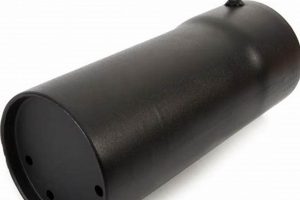A malfunctioning exhaust system component, specifically the rearmost device responsible for noise reduction, can, under certain conditions, trigger the illumination of the malfunction indicator lamp on a vehicle’s dashboard. This light, commonly referred to as a check engine light, signals that the vehicle’s onboard diagnostic system has detected an issue affecting emissions or overall engine performance. While seemingly unrelated, a degraded or damaged component in the exhaust pathway can influence factors monitored by the engine control unit (ECU).
The illumination of this warning light is a crucial indicator for vehicle owners. Addressing the underlying problem promptly prevents potential damage to other components, ensures optimal fuel efficiency, and maintains compliance with emission standards. Historically, exhaust systems were primarily designed for noise reduction. Modern systems, however, play a vital role in emissions control, making their proper function essential for both environmental protection and vehicle longevity.
The relationship between exhaust system integrity and the check engine light activation is explored further, examining the specific mechanisms by which a compromised noise reduction device can influence sensor readings and trigger diagnostic trouble codes. This investigation details the typical causes, related symptoms, and diagnostic procedures associated with this phenomenon.
Addressing potential exhaust system problems proactively is crucial for maintaining optimal vehicle performance and preventing the activation of the malfunction indicator lamp. The following tips offer guidance on identifying, mitigating, and resolving issues that may lead to this warning light appearing due to a compromised exhaust silencer.
Tip 1: Routine Visual Inspection: Regularly examine the underside of the vehicle for signs of physical damage, such as rust, holes, or loose connections. These visual cues often indicate degradation that can affect system performance.
Tip 2: Listen for Unusual Noises: Pay attention to changes in exhaust sound. A louder-than-normal rumble or hissing sound may suggest a leak or internal damage that compromises noise reduction effectiveness.
Tip 3: Monitor Fuel Efficiency: A sudden decrease in fuel economy can signal an exhaust system issue. A damaged or restricted silencer can impact engine efficiency, leading to increased fuel consumption.
Tip 4: Investigate Related Symptoms: Be aware of other potential indicators, such as a burning smell or vibrations felt through the vehicle. These symptoms, when coupled with the illuminated light, provide additional clues.
Tip 5: Professional Diagnostic Scan: If the malfunction indicator lamp illuminates, seek a professional diagnostic scan. This procedure retrieves diagnostic trouble codes that pinpoint the source of the problem, including issues related to exhaust system sensors and performance.
Tip 6: Prompt Repair or Replacement: Addressing exhaust system problems without delay minimizes the risk of further damage to other components, such as the catalytic converter or oxygen sensors. Timely repair or component replacement is essential.
Adhering to these guidelines allows for the early detection and correction of exhaust system faults. This proactive approach contributes to a reduction in potential malfunctions and the avoidance of unnecessary malfunction indicator lamp activation.
By prioritizing regular maintenance and addressing issues promptly, vehicle owners can ensure the longevity and efficiency of the exhaust system, preventing complications that might trigger the check engine light and impact vehicle performance.
1. Exhaust Backpressure
Exhaust backpressure is a critical factor in engine operation and can influence the triggering of the malfunction indicator lamp. A properly functioning exhaust system maintains an optimal level of backpressure, which is essential for efficient combustion and proper scavenging of exhaust gases from the cylinders. An imbalance in exhaust backpressure, often resulting from a deteriorated or damaged silencer, can disrupt engine performance and trigger the diagnostic system.
- Impact on Engine Scavenging
Excessive backpressure impedes the efficient removal of exhaust gases from the cylinders. This incomplete scavenging reduces the amount of fresh air entering the cylinder during the intake stroke, diminishing combustion efficiency. Conversely, insufficient backpressure can lead to poor cylinder filling, similarly affecting combustion quality. A deteriorated silencer with internal obstructions or a complete absence thereof alters the designed backpressure parameters.
- Influence on Oxygen Sensor Readings
Changes in exhaust backpressure directly affect the readings of oxygen sensors. These sensors monitor the oxygen content in the exhaust stream to provide feedback to the engine control unit (ECU) for fuel mixture adjustments. Altered backpressure can skew these readings, leading the ECU to incorrectly adjust the air-fuel ratio. For example, increased backpressure might cause the oxygen sensor to report a lean condition, prompting the ECU to richen the mixture, which can result in reduced fuel economy and increased emissions.
- Relationship with Catalytic Converter Efficiency
Optimal backpressure is vital for the efficient operation of the catalytic converter. This device reduces harmful emissions by converting pollutants into less harmful substances. Imbalances in exhaust backpressure can affect the temperature and flow rate within the catalytic converter, reducing its effectiveness. Over time, this can lead to catalytic converter failure and the illumination of the malfunction indicator lamp, often with codes related to catalytic converter inefficiency.
- Diagnostic Trouble Codes Associated with Backpressure
The engine control unit (ECU) monitors various parameters related to engine performance, including those affected by exhaust backpressure. If the ECU detects deviations from the expected values, it will store a diagnostic trouble code (DTC) and illuminate the malfunction indicator lamp. While a DTC may not directly indicate “backpressure,” codes related to oxygen sensor faults, lean or rich conditions, or catalytic converter inefficiency often point to underlying issues with exhaust backpressure caused by silencer degradation or damage.
The interplay between exhaust backpressure and the vehicle’s diagnostic system highlights the importance of maintaining the integrity of the exhaust system, specifically the silencer. Changes in exhaust backpressure, caused by a degraded or damaged silencer, can disrupt engine performance, skew sensor readings, and reduce the efficiency of the catalytic converter, ultimately leading to the illumination of the malfunction indicator lamp. Addressing these issues promptly is essential for maintaining optimal engine performance, fuel efficiency, and emissions control.
2. Sensor Readings
The integrity of the exhaust system, specifically a component responsible for noise reduction, significantly influences sensor readings monitored by the engine control unit (ECU). Deterioration or damage to this component can disrupt the flow of exhaust gases, altering the readings from sensors such as oxygen sensors and pressure sensors. These sensors provide critical feedback to the ECU, enabling it to adjust fuel delivery and ignition timing for optimal engine performance and emissions control. When these readings deviate from expected parameters due to exhaust system malfunctions, the ECU interprets this as a system fault and may illuminate the malfunction indicator lamp.
For instance, a compromised noise reduction component can lead to exhaust leaks or internal restrictions, affecting the pressure and velocity of exhaust gases. Oxygen sensors, located upstream and downstream of the catalytic converter, detect changes in oxygen levels indicative of the combustion process. Exhaust leaks upstream of these sensors can introduce ambient air into the exhaust stream, causing the upstream sensor to report a lean condition. The ECU may then compensate by enriching the fuel mixture, potentially leading to reduced fuel economy and increased emissions. Conversely, restrictions within the exhaust system can increase backpressure, causing the downstream oxygen sensor to report a rich condition. These incorrect sensor readings trigger diagnostic trouble codes (DTCs) and activate the malfunction indicator lamp.
In summary, the proper functioning of sensors within the exhaust system is directly linked to the physical condition of the exhaust pathway, including the noise reduction component. Altered sensor readings, stemming from exhaust system damage, can cause the ECU to misinterpret engine operating conditions, triggering the malfunction indicator lamp. A thorough understanding of this relationship is crucial for accurate diagnosis and repair of exhaust system-related issues, ensuring optimal engine performance, emissions control, and fuel efficiency.
3. Emission Control
Emission control systems are integral to modern vehicles, designed to mitigate the release of harmful pollutants into the atmosphere. The proper function of these systems is monitored by the vehicle’s onboard diagnostic (OBD) system. A compromised exhaust silencer, while primarily responsible for noise reduction, can indirectly impact emission control and trigger the malfunction indicator lamp.
- Catalytic Converter Functionality
The catalytic converter relies on specific exhaust gas temperatures and flow rates to operate effectively. A damaged silencer, leading to exhaust leaks or increased backpressure, can alter these parameters. Inefficient catalytic converter operation results in elevated levels of pollutants, prompting the OBD system to detect the discrepancy and illuminate the malfunction indicator lamp. For example, if a silencer is severely corroded, it can allow uncombusted hydrocarbons to bypass the catalytic converter, resulting in a failure of an emissions test and activation of the warning light.
- Oxygen Sensor Performance
Oxygen sensors measure the oxygen content in the exhaust stream, providing feedback to the engine control unit (ECU) to optimize the air-fuel mixture. An exhaust leak caused by a faulty silencer can introduce ambient air into the exhaust system, affecting oxygen sensor readings. This leads to inaccurate feedback to the ECU, resulting in improper fuel adjustments and increased emissions. A lean condition reported by the oxygen sensor, due to an exhaust leak near the sensor, can trigger a diagnostic trouble code related to fuel trim or oxygen sensor malfunction.
- Exhaust Gas Recirculation (EGR) System Impact
The EGR system recirculates a portion of the exhaust gas back into the intake manifold to reduce combustion temperatures and nitrogen oxide (NOx) emissions. Exhaust backpressure, influenced by the condition of the silencer, can affect the EGR flow rate. Inconsistent EGR flow can lead to increased NOx emissions and potential malfunction indicator lamp activation. A restricted exhaust system, caused by a collapsed silencer, can impede EGR flow, leading to higher combustion temperatures and NOx formation.
- Evaporative Emission Control System (EVAP) Indirect Influence
While the evaporative emission control system primarily manages fuel vapor emissions, a significantly compromised exhaust system can indirectly influence its operation. Changes in exhaust backpressure can affect engine vacuum, impacting the EVAP system’s ability to properly purge fuel vapors. While less direct, extreme exhaust system issues can contribute to EVAP system faults and subsequent warning light activation. For example, excessive backpressure can affect the engine’s ability to draw a vacuum, impacting the proper functioning of EVAP purge valves.
The interplay between these emission control facets and the condition of the exhaust silencer underscores the importance of maintaining the entire exhaust system. While the silencer’s primary function is noise reduction, its condition directly affects the efficiency of various emission control components. A degraded silencer can trigger the malfunction indicator lamp through its impact on catalytic converter functionality, oxygen sensor performance, EGR system operation, and potentially the EVAP system, emphasizing the interconnectedness of vehicle systems and the need for comprehensive diagnostics.
4. Fuel Efficiency
A compromised exhaust noise reduction device, also known as a muffler, can indirectly impact fuel efficiency and, subsequently, contribute to the illumination of the malfunction indicator lamp. While the primary function is sound attenuation, its degradation can alter exhaust flow dynamics, affecting engine performance parameters that influence fuel consumption. Increased backpressure, resulting from internal obstructions within a deteriorated muffler, forces the engine to work harder to expel exhaust gases. This increased workload necessitates additional fuel consumption to maintain the desired power output, thereby reducing fuel efficiency. Conversely, significant muffler damage, such as large holes or complete detachment, can reduce backpressure below the optimal range. This imbalance also disrupts efficient combustion, impacting fuel economy.
Reduced fuel efficiency resulting from a malfunctioning muffler can manifest in several ways. Vehicle owners may observe a decrease in miles per gallon (MPG) during regular driving. The engine may exhibit symptoms such as sluggish acceleration or reduced power, particularly at higher speeds. These performance deficits prompt the engine control unit (ECU) to compensate by adjusting the air-fuel mixture, potentially leading to increased fuel consumption. Moreover, deviations from optimal exhaust flow can influence oxygen sensor readings, causing the ECU to make inaccurate fuel adjustments. For instance, increased backpressure can cause a rich-running condition, where the engine receives more fuel than necessary, leading to both decreased fuel efficiency and increased emissions. This, in turn, can trigger the malfunction indicator lamp with codes related to oxygen sensor malfunctions or rich fuel conditions.
Maintaining the integrity of the exhaust system, including the noise reduction device, is therefore crucial for optimizing fuel efficiency. Regular inspections for signs of damage or corrosion are essential for preventing performance degradation and potential malfunction indicator lamp activation. Addressing exhaust system issues promptly not only restores proper engine function but also ensures that the vehicle operates within its designed fuel efficiency parameters. This proactive approach minimizes unnecessary fuel consumption and reduces the risk of triggering the warning light due to fuel-related imbalances detected by the ECU. Prioritizing exhaust system maintenance translates directly into tangible benefits such as lower fuel costs and reduced environmental impact.
5. Diagnostic Codes
Malfunction indicator lamp illumination frequently correlates with stored diagnostic codes within the vehicle’s engine control unit (ECU). These codes, retrieved via diagnostic scan tools, serve as crucial indicators of system malfunctions, including those indirectly linked to a compromised exhaust silencer. While a diagnostic code might not directly specify “faulty silencer,” certain codes suggest exhaust system anomalies potentially stemming from its degradation. For instance, codes indicating oxygen sensor imbalances (e.g., P0171, P0174 for lean conditions; P0172, P0175 for rich conditions) can result from exhaust leaks caused by a corroded or damaged silencer. Similarly, codes related to catalytic converter inefficiency (e.g., P0420) may arise from altered exhaust gas flow or temperature fluctuations attributed to a silencer malfunction impacting catalytic converter operation.
The interpretation of diagnostic codes requires consideration of associated symptoms and system interactions. A vehicle exhibiting reduced fuel economy, unusual exhaust noises, and an illuminated malfunction indicator lamp with an oxygen sensor-related code warrants a comprehensive inspection of the entire exhaust system, including the silencer. The presence of rust, holes, or structural damage on the silencer, combined with the aforementioned diagnostic codes, strengthens the correlation between the silencer’s condition and the recorded fault. The diagnostic process involves not only retrieving codes but also analyzing sensor data, performing visual inspections, and conducting system tests to pinpoint the root cause of the malfunction. Substituting components based solely on diagnostic codes without thorough investigation can lead to misdiagnosis and unnecessary repairs.
Diagnostic codes provide a starting point for troubleshooting vehicle malfunctions, including those indirectly caused by a failing exhaust component responsible for noise reduction. A systematic approach, incorporating code interpretation, symptom analysis, and component testing, is essential for accurate diagnosis and effective repair. While no code definitively states “replace silencer,” patterns of related codes, coupled with visual evidence of exhaust system degradation, implicate the silencer as a potential source of the problem. Correctly interpreting diagnostic information ensures appropriate repairs are performed, restoring vehicle performance and preventing further damage to other system components.
6. Catalytic Converter
The catalytic converter, a crucial component in a vehicle’s emission control system, is indirectly affected by the condition of the exhaust silencer. While the silencer primarily reduces noise, its deterioration can influence the operation of the catalytic converter, leading to the activation of the malfunction indicator lamp. Increased exhaust backpressure, resulting from a damaged or obstructed silencer, can elevate the operating temperature of the catalytic converter. This overtemperature condition accelerates the degradation of the catalytic converter’s internal components, diminishing its ability to effectively reduce harmful emissions.
For instance, consider a vehicle with a severely corroded silencer causing significant exhaust restriction. The elevated backpressure forces the catalytic converter to operate at temperatures beyond its design specifications. Over time, this excessive heat leads to thermal breakdown of the catalyst material, reducing its efficiency in converting hydrocarbons, carbon monoxide, and nitrogen oxides into less harmful substances. Consequently, the vehicle’s onboard diagnostic system detects the reduced efficiency of the catalytic converter via oxygen sensor readings and triggers the malfunction indicator lamp, often accompanied by diagnostic trouble code P0420 indicating catalytic converter efficiency below threshold. Replacing only the catalytic converter without addressing the underlying exhaust restriction caused by the faulty silencer may result in premature failure of the new catalytic converter and recurrence of the warning light.
In summary, the interplay between the exhaust silencer and catalytic converter emphasizes the importance of maintaining the entire exhaust system. While the silencer’s primary function is noise reduction, its condition has a direct impact on the longevity and efficiency of the catalytic converter. A compromised silencer can lead to increased exhaust backpressure and elevated temperatures, accelerating the degradation of the catalytic converter and triggering the malfunction indicator lamp. Addressing exhaust system issues holistically, including both the silencer and catalytic converter, is essential for restoring proper emissions control and preventing future malfunctions.
Frequently Asked Questions
This section addresses common inquiries regarding the correlation between the condition of the exhaust system, specifically the silencer, and the illumination of the malfunction indicator lamp.
Question 1: Can a deteriorated exhaust system component trigger the check engine light?
Yes, a compromised exhaust system, including a damaged silencer, can indirectly cause the malfunction indicator lamp to illuminate. Altered exhaust flow, pressure, or sensor readings resulting from the damage can trigger the light.
Question 2: How does a malfunctioning silencer impact sensor readings?
A degraded silencer can lead to exhaust leaks, altered backpressure, and temperature fluctuations. These changes can skew readings from oxygen sensors and other exhaust-related sensors, leading the engine control unit (ECU) to detect a fault.
Question 3: What diagnostic trouble codes are commonly associated with exhaust system issues?
Common codes include those related to oxygen sensor malfunctions (e.g., P0171, P0174, P0172, P0175), catalytic converter inefficiency (e.g., P0420), and fuel trim imbalances. These codes often point to underlying exhaust system problems.
Question 4: Does a damaged exhaust silencer directly impact catalytic converter performance?
Yes, a compromised silencer can affect catalytic converter performance. Changes in exhaust flow and temperature caused by the damage can reduce the catalytic converter’s efficiency, leading to increased emissions and potential warning light activation.
Question 5: Can reduced fuel efficiency be an indicator of a faulty exhaust silencer?
Yes, a noticeable decrease in fuel economy can suggest an exhaust system issue, including a damaged silencer. Altered exhaust flow dynamics influence engine performance and fuel consumption, potentially triggering the malfunction indicator lamp.
Question 6: Is prompt repair of exhaust system damage essential for preventing further complications?
Yes, timely repair or replacement of damaged exhaust system components is crucial for preventing potential damage to other parts, ensuring optimal fuel efficiency, and maintaining compliance with emissions standards.
Maintaining the integrity of the exhaust system is crucial for preventing malfunction indicator lamp activation and preserving overall vehicle performance. A compromised silencer can indirectly impact sensor readings, catalytic converter functionality, and fuel efficiency, all of which can trigger the warning light.
Consider consulting with a qualified technician for diagnostic assessment and necessary repairs if the malfunction indicator lamp illuminates.
Conclusion
This exploration has demonstrated that a compromised exhaust silencer, while primarily responsible for noise reduction, can indeed indirectly trigger the malfunction indicator lamp. The relationship is complex, stemming from the silencer’s influence on exhaust flow, sensor readings, catalytic converter efficiency, and ultimately, overall engine performance. A degraded or damaged silencer can disrupt these factors, leading to diagnostic trouble codes and activation of the warning system. Therefore, the assumption that the exhaust system component responsible for noise reduction is solely linked to sound attenuation is erroneous; its condition significantly impacts broader vehicle operation and diagnostic monitoring.
The activation of the malfunction indicator lamp should be regarded as a serious indication of potential system malfunction, warranting prompt diagnostic investigation. Neglecting exhaust system integrity can lead to further component damage, reduced fuel efficiency, increased emissions, and potential regulatory non-compliance. Vigilant vehicle maintenance, including regular inspection of exhaust components, is essential for preventing such complications and ensuring long-term vehicle reliability.







